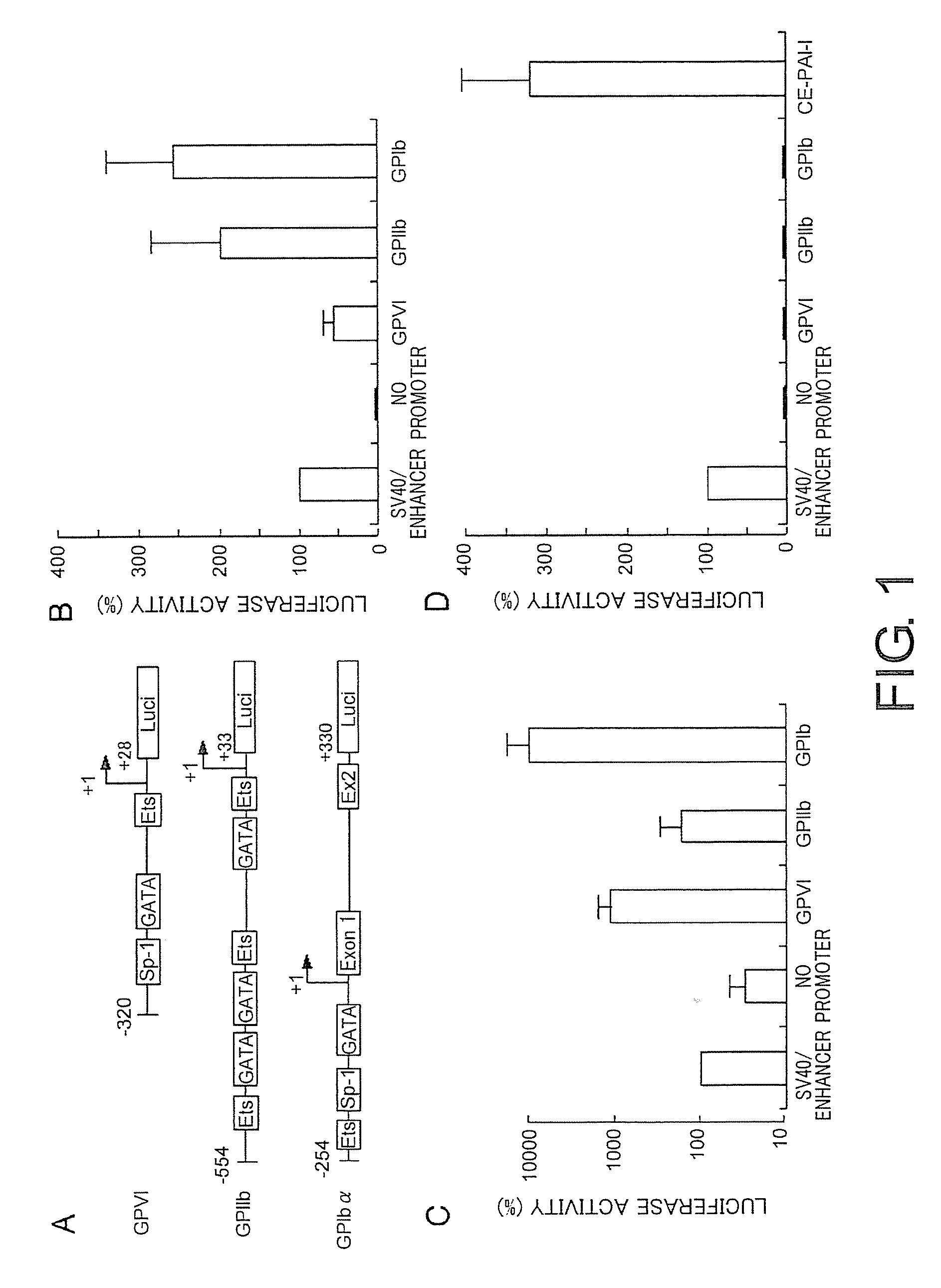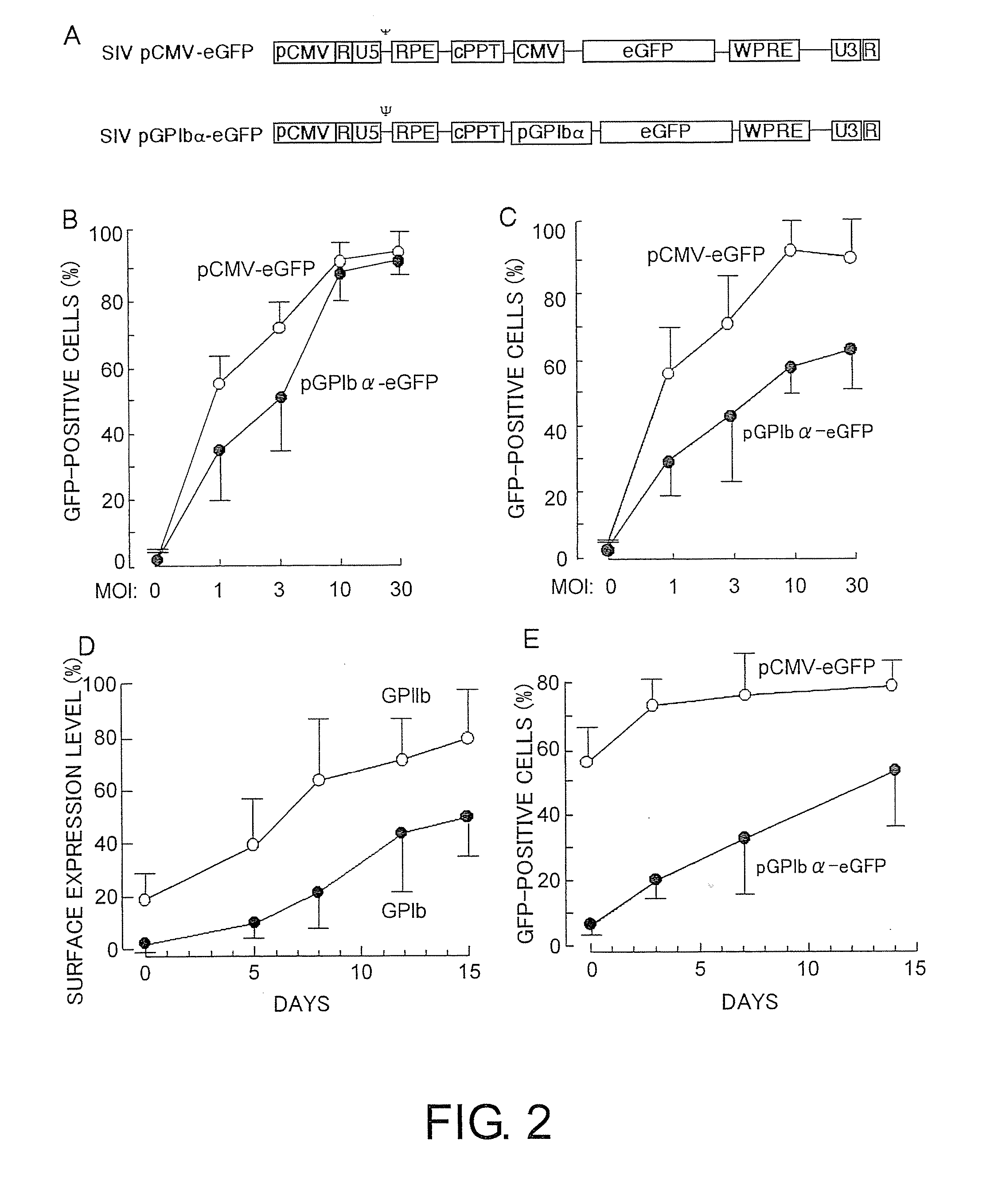Therapeutic method for blood coagulation disorder
a blood coagulation disorder and therapy method technology, applied in the field of blood coagulation abnormalities, can solve the problems of difficult repair of disease causes, abnormal blood coagulation mechanism, administration of blood formulations prepared from human blood, etc., to achieve stable blood coagulation ability, improve blood coagulation ability, and sufficient treatment
- Summary
- Abstract
- Description
- Claims
- Application Information
AI Technical Summary
Benefits of technology
Problems solved by technology
Method used
Image
Examples
example 1
Comparison of the Luciferase Reporter Expression Promoted by the Platelet-Specific Promoter
[0280]First, the present inventors compared the activities of promoters of three platelet-specific genes, i.e. GPIIb, GPIbα, and GPVI, in megakaryocytes to achieve efficient expression of the target gene in platelets. FIG. 1A shows a schematic illustration of the platelet-specific promoters used in this study, along with regulatory factors specific to the promoters. Various promoters were compared for their promoter activities using the luciferase reporter gene. The present inventors used nucleotide regions of promoters which had the highest activity in previous studies (Prandini, M. H., Uzan, G., Martin, F., Thevenon, D., and Marguerie, G. (1992) Characterization of a specific erythromegakaryocytic enhancer within the glycoprotein IIb promoter. J. Biol. Chem. 267, 10370-10374; Hashimoto, Y, and Ware, J. (1995) Identification of essential GATA and Ets binding motifs within the promoter of the ...
example 2
Efficient Transformation of Megakaryocytes by SIV-Based Vectors
[0283]The present inventors constructed two SIV-based lentiviral vectors carrying the eGFP gene under the control of either the CMV promoter (SIV-pCMV-eGFP) or the GPIbα promoter (SIV-pGPIbα-eGFP). The transgene located downstream of the CMV promoter (pCMV) or GPIbα promoter (pGPIbα) was inserted between the LTR-containing elements (U3, R, and U5; FIG. 2A) of a SIV-derived vector (FIG. 2A). A posttranscriptional regulatory factor derived from woodchuck hepatitis virus (WPRE) was inserted downstream of the expressed gene to increase gene expression in the transduced cells.
[0284]To investigate the transduction of eGFP gene into megakaryocytes, UT-7 / TPO or CD34+-derived megakaryocytes were incubated for 24 hours in the presence of SIV-pCMV-eGFP or SIV-pGPIbα-eGFP at various concentrations. Both constructs efficiently transduced the eGFP gene into UT-7 / TPO and CD34+-derived megakaryocytes (FIG. 2B). When the cells were incub...
example 3
Establishment of Efficient Transduction of KSL Cells Carrying SIV Vector
[0286]Next, the present inventors optimized the transduction protocol for KSL cells by using an SIV vector carrying the eGFP gene promoted by the CMV promoter. The efficiency of eGFP transduction in cultured KSL cells reached 60% to 80% (FIG. 3A). The plateau value for transduction was observed at an MOI of 10 to 30. One day (24 hours) after incubation with the viral vector was sufficient to achieve a high expression of the transduced gene. The expression level of eGFP then gradually decreased (FIG. 3B). The decrease of eGFP expression can be due to a reduction in cell viability. This is because PI-positive cells (dead cells) increased with time (data not shown). Thus, the present inventors cultured KSL at an MOI of 30 for 24 hours and transplanted the cells into recipient mice in the subsequent experiments.
PUM
| Property | Measurement | Unit |
|---|---|---|
| Therapeutic | aaaaa | aaaaa |
| Coagulation enthalpy | aaaaa | aaaaa |
Abstract
Description
Claims
Application Information
 Login to View More
Login to View More - R&D
- Intellectual Property
- Life Sciences
- Materials
- Tech Scout
- Unparalleled Data Quality
- Higher Quality Content
- 60% Fewer Hallucinations
Browse by: Latest US Patents, China's latest patents, Technical Efficacy Thesaurus, Application Domain, Technology Topic, Popular Technical Reports.
© 2025 PatSnap. All rights reserved.Legal|Privacy policy|Modern Slavery Act Transparency Statement|Sitemap|About US| Contact US: help@patsnap.com



